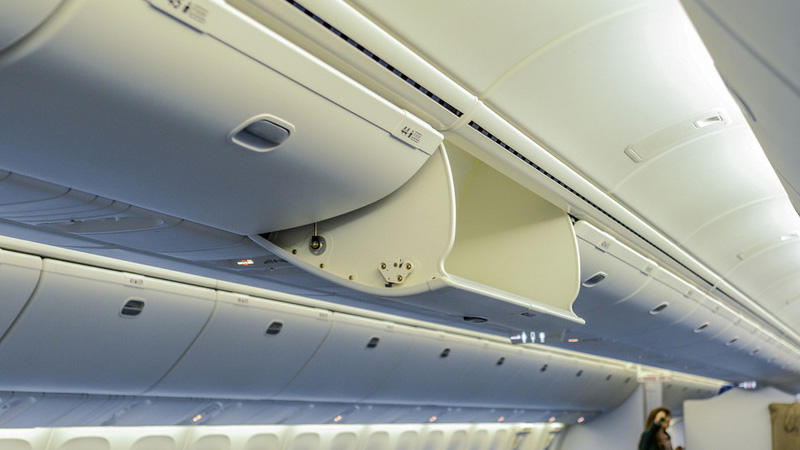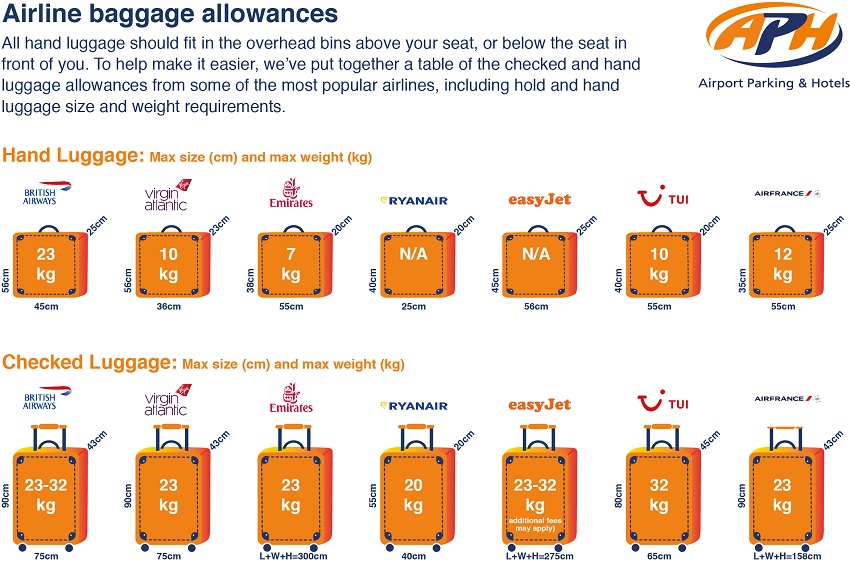We’ve all been there – the mad rush to fit everything into one suitcase and the struggle to weigh your luggage bags on your bathroom scales. The worry as you approach the check-in desk, wondering if your bag will tip the scales, while trying to hide your handbag in your carry-on before you board the flight.

The good news? It doesn’t have to be this stressful. We’ve got some top tips to help you prepare your packing the right way.
Airline baggage allowances
All hand luggage should fit in the overhead bins above your seat, or below the seat in front of you. To help make it easier, we’ve put together a table of the checked and hand luggage allowances from some of the most popular airlines, including hold and hand luggage size and weight requirements.

| Hand Luggage | Checked Luggage | |||
| Maximum Size (cm) | Maximum Weight (kg) | Maximum Size (cm) | Maximum Weight (kg) | |
| British Airways | 56 x 45 x 25 | 23 | 90 x 75 x 43 | 23-32 |
| Virgin Atlantic | 56 x 36 x 23 | 10 | 90 x 75 x 43 | 23 |
| Emirates | 55 x 38 x 20 | 7 | L + W + H = 300 | 23 |
| Ryanair* | 25 x 40 x 20 | N/A | 55 x 40 x 20 | 20 |
| easyJet | 56 x 45 x 25 | N/A | L + W + H = 275 | 23-32 (additional fees may apply) |
| TUI | 55 x 40 x 20 | 10 | 80 x 65 x 45 | 32 |
| Air France | 55 x 35 x 25 | 12 | L + W + H = 158 | 23 |
*Based on non-priority boarding. Those with priority boarding are allowed a 10kg wheelie case at 55cm x 40cm x 20cm.
While these dimensions are the average, some airlines have variants in their allowances. For example, if you’re flying with Emirates state and you’re carrying a wheelie bag onto the plane, the total dimensions of your case should add up to less than 114cm. So it’s important to do some additional research beforehand if you think it may apply. But what else should you look out for?
- Some airlines and flights allow for passengers who are travelling with hand luggage only to add an extra bag to take on the cabin for an additional fee.
- Children and babies may have different allowances – so if you’re travelling with little ones be sure to check this information out.
- With some airlines, the baggage allowances can vary depending on what class you’re seated in, so be sure you do your research beforehand if you think this may apply to you.
- Some airlines also allow you to carry additional luggage pieces – depending on class of travel and/or additional costs.
How to measure luggage size for air travel
So, what’s the easiest way to make sure that you’re not travelling with too much? Measuring your luggage before you go will save you the worry of having to rummage through your case at the check-in desk to spread out the weight.
If you’re struggling to balance your wheelie case on your scales at home, turn it to the side so that the wheels are facing outwards. Still can’t see the results? Weigh yourself in kilograms, then weigh yourself again while carrying your case, and the difference between the two numbers is the weight of your luggage! Or, you can purchase a handheld scale – ideal for frequent travellers.
But what about the size? Typically, suitcases are measured from the ground to the top of the carry handle – not including the telescopic handle (the bit that you pull your suitcase with). You can check the online specifications for your suitcase to easily find the measurements, or take a tape measure and note down the measurements for the height, width and depth of your case to make sure it’s not too big.
Non-standard travel luggage allowances
From travelling with camera equipment and musical instruments, to heading off on a ski trip with your own gear and additional garment bags, there are plenty of reasons why you may need to check out allowances for non-standard travel luggage. This varies from airline to airline, but typically most items can be checked in and carried on board, although some restrictions may apply to bigger items or a large number of items. Some sports equipment, like golf clubs, bicycles and skis will count towards your standard baggage allowance, so you may need to purchase additional space to carry your everyday necesseties. We would suggest getting in touch with your airline to arrange the necessary transport for your non-standard luggage before you leave, so that you can travel safely with your belongings.
Top Tip
If you’re travelling with additional bulky luggage and sporting equipment, avoid the hassle of an airport transfer bus by booking meet and greet parking. A drive-up and drop-off service that allows you to park up just moments from the check-in desk, so you can avoid fighting your way onto a transfer bus with your additional luggage.
Airline baggage FAQs
Need to know more about airline baggage restrictions? We’ve answered some of the FAQs related to travel luggage below.
Yes! Travelling with plug adapters is often a necessity, so you’ll find that this isn’t usually an issue. Although we would recommend travelling with fully charged devices – as you may be asked to switch it on at security, as well as placing it in a separate bin from your other personal belongings. This is just so that your electronic devices can be screened properly.
There are restrictions that come with taking liquids onto flights. So if there are liquids that you need to take in your hand luggage, make sure that:
– They’re stored in 100ml containers
– All containers are comfortably sealed in a, clear, resealable plastic bag – measuring approximately 20cm x 20cm and containing no more than 1L
– There is only one bag per person
– The bag is out and on display when going through security
Where possible, we recommend that you pack any liquids in your hold luggage to avoid any hassle at security.
That depends on where you’re going and what you’re doing. Heading on an outdoor adventure? A travel rucksack is the ideal piece of luggage for your trip. Or are you on your way to a month-round trip to see the sights? You’ll probably need something a little bigger. Whereas a smaller, hand luggage sized bag may be better for those heading on a business or weekend break. But for those who like to pack heavy or are heading on a long-haul holiday, a decent suitcase is the best piece of luggage to carry everything. But remember, you’re likely to fit more luggage into a softshell case than one with a hard exterior, because there’s more give in the fabric and the case can expand a little. They also often weigh less than hard cases so if you’re already struggling with the weight limits, a lighter, softshell suitcase may be better for you!
Top Tip
If you’re heading off on a long-haul trip with your family and lots of luggage, plan ahead and book an overnight stay in an airport hotel. That way, you’ll have the comfort of knowing that you’re only a few steps away from the check-in desks when you wake up.
So now your trip is booked and your packing is sorted – you’re ready to go! But it’s never too late to book your Meet and Greet airport parking. Start your journey off the right way by planning ahead so you can have a stress-free trip, no matter where you’re headed. From booking your hotel and restaurants, to finding the best airport parking package for you. But don’t worry if you’re not a great planner. Did you know that you can book your airport parking with APH just 3 hours ahead of your flight? So no matter what, you can be prepared.
Airline extras, such as checked luggage, seat assignments, and meals, can add significantly to the cost of your flight. However, there are a few things you can do to minimize the impact of these extras on your budget.
